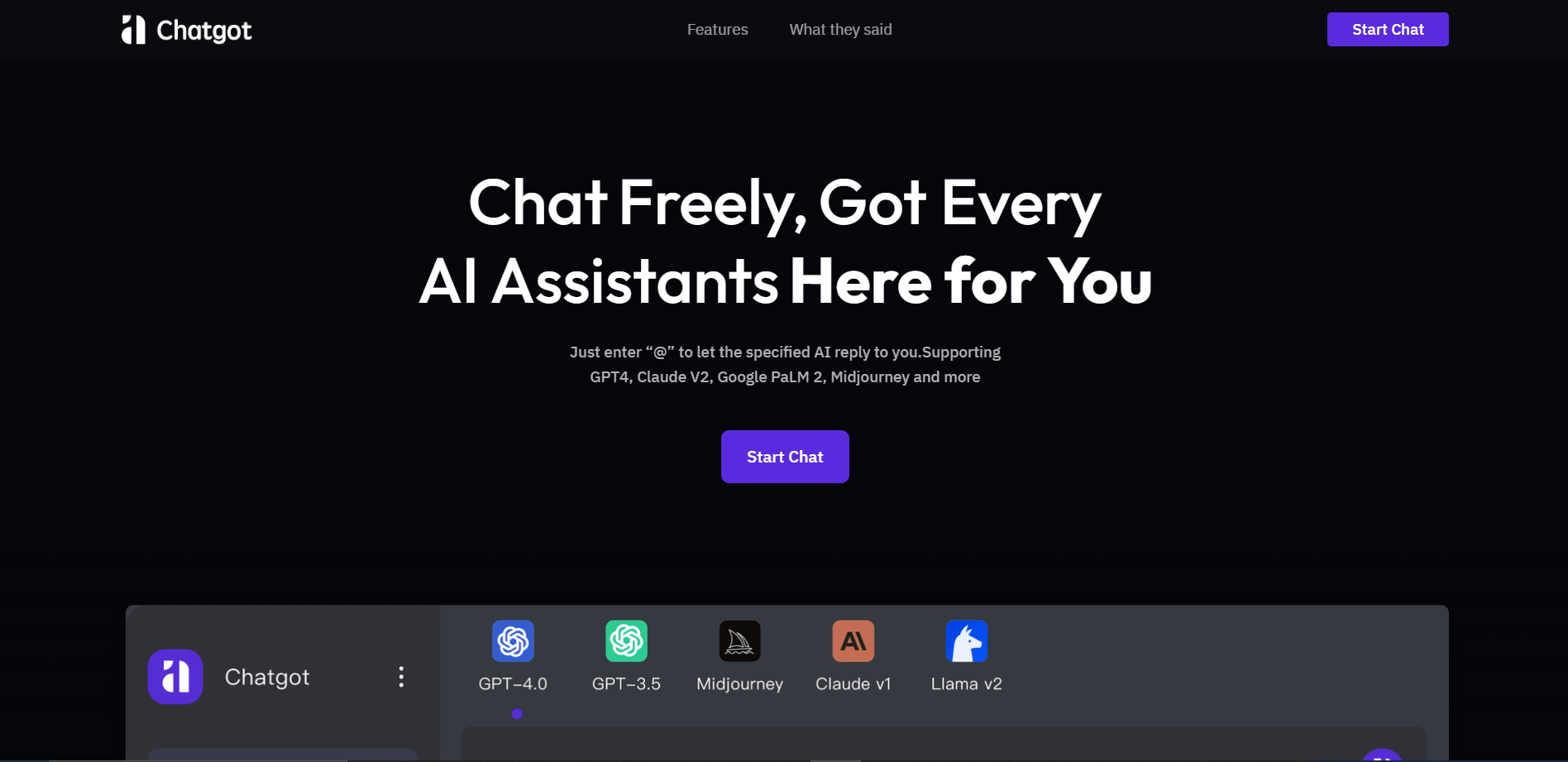In the rapidly evolving world of artificial intelligence, platforms like Chatgot.io are reshaping how we interact with machines, offering users a dynamic, multi-dimensional experience. Chatgot.io is a revolutionary AI platform that integrates multiple AI chat assistants into one cohesive interface. It allows users to engage with different AI personalities, each specialized in specific tasks or knowledge areas, providing tailored insights for any query. The platform also adds a creative dimension, featuring an artistic tool where users can request unique illustrations from @Midjourney, a drawing AI.
This article dives into the key features, pros, cons, and alternatives of Chatgot.io, highlighting why it is making waves in the AI conversation landscape and exploring similar platforms that offer unique functionalities.
What is Chatgot.io?
Chatgot.io is an innovative platform that merges various AI personalities into a single application, allowing users to access specialized expertise on any subject. By simply using the @ symbol, users can direct questions to specific bots, ensuring they receive specialized, focused responses. For example, if a user is seeking a technical explanation, they can tag an AI specialized in that domain, while for creative queries, they can direct questions to an AI with a more artistic focus. This multi-AI integration allows for more nuanced conversations and diverse perspectives, fostering richer interactions.
Moreover, Chatgot.io features an AI tool, where users can request illustrations from Midjourney, a specialized AI drawing bot. This feature is a significant draw for those seeking creative content alongside their informative conversations.
In addition, Chatgot.io offers an interactive evaluation feature, where one AI can critique or provide feedback on another’s response. This adds a layer of fun, critical thinking, and deeper engagement, making the platform not only functional but also entertaining.
Key Features of Chatgot.io
- Real-Time Messaging: Chatgot.io facilitates instant communication, allowing users to engage in seamless conversations with no delays.
- User-Friendly Interface: The platform is designed for ease of use, ensuring that users, regardless of their technical expertise, can navigate the app effortlessly.
- Multi-AI Integration: Chatgot.io brings multiple specialized AI personalities into a single interface, allowing for varied and in-depth responses based on different fields of expertise.
- Customizable Settings: Users can personalize their chat experience according to their preferences, adjusting things like notifications, themes, and workflow configurations.
- AI Artistry: The @Midjourney feature enables users to create unique, personalized illustrations, making the platform ideal for both informative and creative tasks.
- Interactive AI Evaluations: AI bots can critique one another’s responses, promoting a sense of fun, learning, and critical thinking.
- Multi-Platform Support: Chatgot.io is accessible on a wide range of devices, making it convenient for users to engage with the platform on mobile, tablet, or desktop.
- Secure Communication: The platform employs robust encryption techniques to ensure user privacy and security.
Pros of Chatgot.io
- Multi-AI Integration: The ability to access various AI personalities within one platform provides users with a broader and more diverse range of responses, ensuring they get specialized advice for a variety of topics.
- Targeted Expertise: The platform allows users to tag specific AI bots using the @ symbol, making it easier to direct questions to experts in specific fields.
- Diverse Perspectives: By tagging multiple AIs in a single question, users can compare different viewpoints, deepening their understanding of a subject.
- Creative Output: Chatgot.io’s AI Artistry tool (@Midjourney) adds a creative edge to the platform, enabling users to request custom illustrations.
- Interactive and Fun: The interactive evaluation feature brings an element of fun and engagement, allowing one AI to critique the responses of another, fostering a dynamic environment for users to learn.
Cons of Chatgot.io
- Limited User Customization: While Chatgot.io offers some customization options, users might find that the interface and workflow customization is somewhat limited compared to more traditional platforms.
- Steep Learning Curve: New users may initially struggle with understanding the full range of features and functionalities, especially when it comes to utilizing the multiple AI integrations.
- Integration Complexity: For businesses or developers looking to integrate Chatgot.io with existing systems, the process might be more complex and require technical expertise.
- Cost Barrier for Small Businesses: Depending on the pricing structure, small businesses or startups might find Chatgot.io’s services a bit expensive, making it less accessible for budget-conscious users.
- Dependent on Internet Connectivity: As with most cloud-based services, a stable internet connection is essential for effective use. In regions with poor connectivity, this could be a significant limitation.
Top 10 Alternatives to Chatgot.io
While Chatgot.io is a powerful and versatile platform, there are several other AI-driven platforms that offer similar or unique capabilities for users seeking specialized AI interactions, creative content, or multi-faceted AI experiences. Below are ten noteworthy alternatives to Chatgot.io:
1. ChatGPT by OpenAI
Overview: OpenAI’s ChatGPT is one of the most well-known conversational AIs. It offers advanced natural language processing and can perform a wide variety of tasks, from answering questions and generating creative content to solving complex technical problems.
Pros:
- Extensive knowledge base
- Versatile functionality (coding, writing, problem-solving)
- Continuous updates and improvements
Cons:
- Lacks multiple specialized AI bots in one platform
- May occasionally generate inaccurate responses
2. Google Bard
Overview: Google’s Bard is a conversational AI designed to enhance the Google search experience by providing natural language responses and creative outputs.
Pros:
- Real-time information retrieval
- Deep integration with Google’s search capabilities
Cons:
- Limited conversational depth
- Less customizable than some alternatives
3. Microsoft Copilot
Overview: Microsoft Copilot integrates OpenAI’s GPT technology into Microsoft Office tools like Word, Excel, and Outlook, offering productivity-driven AI assistance.
Pros:
- Seamlessly integrates with Microsoft Office tools
- Great for professional and business-related tasks
Cons:
- Limited to Microsoft’s ecosystem
- Less focused on conversational AI compared to Chatgot.io
4. Claude by Anthropic
Overview: Claude by Anthropic is an ethical AI focused on safety and alignment. It is designed to ensure that AI-generated content is ethical, transparent, and aligned with human values.
Pros:
- Focus on ethical AI use
- Transparent decision-making process
Cons:
- May be less creative or detailed than other models like ChatGPT
- Limited general-purpose capabilities
5. Jasper AI
Overview: Jasper AI is a content creation tool primarily aimed at marketers, writers, and businesses. It helps generate blog posts, ad copy, and other marketing materials.
Pros:
- Specialized in marketing and content creation
- Offers templates for easy use
Cons:
- Focused on writing rather than broad conversational AI
- Lacks multi-AI integration
6. Replika
Overview: Replika is a chatbot designed to be a companion, offering personal conversations and emotional support.
Pros:
- Focus on personal, empathetic conversations
- AI companion for mental health and wellness
Cons:
- Limited to emotional support and casual conversation
- Not as versatile for business or technical tasks
7. Mistral AI
Overview: Mistral AI is an open-source conversational AI platform that allows users to build custom chatbots and integrate them into various applications.
Pros:
- Open-source and customizable
- Suitable for enterprise-level applications
Cons:
- Requires technical knowledge for implementation
- Not as polished as commercial products
8. Dialogflow by Google Cloud
Overview: Dialogflow is a Google Cloud-based platform for building conversational interfaces for websites, apps, and devices.
Pros:
- Powerful integration with Google Cloud services
- Highly customizable for developers
Cons:
- Requires coding skills for effective use
- Not focused on general conversational use
9. Bing Chat
Overview: Bing Chat integrates OpenAI’s GPT technology with Microsoft’s Bing search engine, offering a powerful search assistant with conversational capabilities.
Pros:
- Real-time search capabilities
- Powered by GPT-4
Cons:
- Limited to search and information retrieval
- Lacks broader AI integration like Chatgot.io
10. Rasa
Overview: Rasa is an open-source conversational AI platform focused on providing companies with the tools to build custom AI chatbots and virtual assistants.
Pros:
- Customizable and open-source
- Great for developers and businesses
Cons:
- Requires technical expertise
- Not as easy to use for non-developers
Conclusion
Chatgot.io is a groundbreaking platform that combines diverse AI personalities and creative tools like @Midjourney to offer a multi-faceted conversational experience. Whether you’re seeking technical insights, creative content, or just a fun interaction with AI, Chatgot.io provides a unique environment to explore artificial intelligence. However, its pricing and complexity might not suit everyone. For users seeking alternatives, platforms like ChatGPT, Google Bard, and Claude offer specialized functionality, while Jasper AI and Replika cater to niche use cases like content creation and emotional support. Ultimately, the right AI platform for you will depend on your specific needs—whether it’s AI-powered business productivity, creative illustration, or personalized conversation.


Leave a Reply